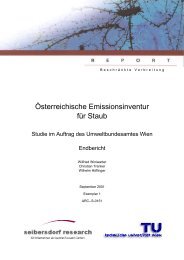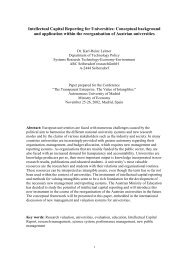ALPMON FINAL REPORT - ARC systems research
ALPMON FINAL REPORT - ARC systems research
ALPMON FINAL REPORT - ARC systems research
Create successful ePaper yourself
Turn your PDF publications into a flip-book with our unique Google optimized e-Paper software.
Contract ENV4-CT96-0359 <strong>ALPMON</strong><br />
level. For reaching an operational level it is essential to work with the data bases of the official<br />
administrations. During the last years the administrations working with area related data are starting to<br />
change data holding and data management from analogue to digital <strong>systems</strong>. This process is normally<br />
combined with an update of existing data bases. On account of the large amount of data to be<br />
transformed for an area as large as the alpine chain, this process will last for a couple of years.<br />
The topics dealing with methodology development have to be addressed from scientists working in the<br />
remote sensing and GIS domain like the consortium working together in the frame of <strong>ALPMON</strong>.<br />
3.4.1 Satellite Sensors and Auxiliary Data<br />
Working for <strong>ALPMON</strong> we have been forced to live with some unexpected limitations, from which the<br />
missing of high resolution RS data was one of the most sever ones. <strong>ALPMON</strong> started with the expectancy<br />
on high resolution satellite data. Most of the expected sensors failed. Only Ikonos was launched<br />
successfully in June 1999, but still today non of the test areas of <strong>ALPMON</strong> was registered. Under this<br />
conditions, the value adding effect of high resolution data sets is still an open topic.<br />
The availability of high resolution remote sensing satellites in the near future will be an essential step<br />
forward. The investigation proved, that at the envisaged scale of 1:25.000, the most urgent need for<br />
thematic evaluations is in higher radiometric and temporal resolutions. Our hope is, that the high<br />
geometric resolution <strong>systems</strong> announced will satisfy with respect to radiometric performance also. A list of<br />
planned, failed and successful launched EO <strong>systems</strong> can be found under<br />
http://www.itc.nl/~bakker/launch-table.html .<br />
Table 21: Status of launches planned in 1998 (EARSeL Journal, 03.98)<br />
Date spacecraft country best resolution success<br />
20 March Spot 4 France 10 m March 1998<br />
March Ikonos 1 USA, commercial 1 m Failed<br />
after March Clark USA 3 m Failed<br />
Quarter 1 CRSS 1 USA, commercial 1 m Failed<br />
30 June EOS AM 1 (Terra<br />
Sat)<br />
USA 15 m December 1999<br />
9 July Landsat 7 USA 15 m April 1999<br />
mid EROS A USA/Israel 1 m<br />
November Ikonos 2 USA, commercial 1 m August 99<br />
Late Quick Bird USA, commercial 1 m Postponed<br />
Late NMP/EO 1 USA 10 m, 315 bands postponed<br />
End OrbView 3 USA, commercial 1 m Postponed<br />
1998 CBERS 1 China/Brazil 20 m<br />
E.g. for the monitoring of alpine pastures by means of classification very high resolution multi-spectral<br />
scenes are demanded. Satellite images from IKONOS could be a solution. Yet, due to the lack of such<br />
data, for the monitoring of landscape changes in the Tarvisio test site visual interpretation of aerial<br />
photos from 1954 and the fusion image of 1992 has been necessary, as these data do not allow<br />
automatic classification due to their radiometric properties. But, as described in section 3.1.2 and Table<br />
19, visual interpretation is more expensive and time consuming than satellite image classification.<br />
Sensor calibration coefficients: Delivery of in-flight calibration coefficients with each band, which is<br />
needed for sensor calibration (see radiometric correction). Momentarily, this is only possible with the<br />
acquisition of Landsat 7 data.<br />
DEM: At the starting point of <strong>ALPMON</strong>, being aware of the fact, that DEM with the grid width requested<br />
for an optimal topographic normalisation of 0,25 (4 times better) of the ground resolution of satellite data<br />
are not available from the administration for the entire alpine chain, it was planned to investigate whether<br />
this problem might be solved or at least approached by using DEM calculated from stereo on track<br />
satellite data. To normalise data of the operational satellites of the Landsat, Spot or IRS class, MOMS-2P<br />
stereo data sets have been assumed to be appropriate, promising DEM accuracy of around 6 m (pixel<br />
size of the high resolution panchromatic band). For evaluating data of the high resolution <strong>systems</strong><br />
expected during the planning stage of <strong>ALPMON</strong>, the DEM calculation from Quick Bird stereo data sets<br />
was envisaged. Unfortunately both <strong>systems</strong> failed, so during lifetime of <strong>ALPMON</strong> it was not possible to<br />
check the real improvement by these opportunities.<br />
Geocoding as well as topographic normalisation is strongly dependent on the accuracy of the available<br />
DEM. The demand of a sub-meter DEM for correcting data with 1 m pixel size like the ones from the<br />
JR, RSDE, ALU, LMU, Seibersdorf, WSL 86




